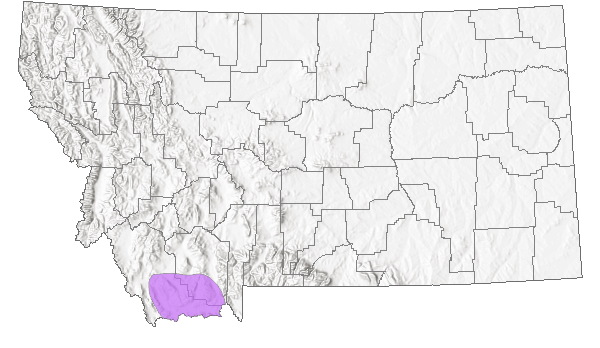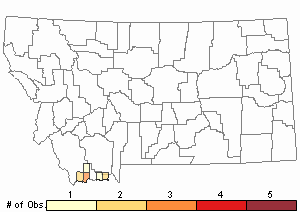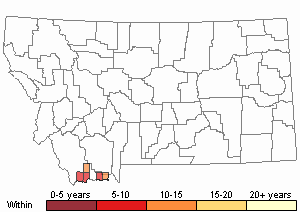View in other NatureServe Network Field Guides
NatureServe
Montana
Utah
Wyoming
Idaho
Wisconsin
British Columbia
South Carolina
Yukon
California
New York
Bruneau Mariposa Lily - Calochortus bruneaunis
Other Names:
Calochortus nuttallii var. bruneaunis
State Rank Reason (see State Rank above)
Globally, Calochortus bruneaunis only occurs in southeast Oregon to eastern California and east to northwest Utah, southwest Montana, and east Idaho. In Montana it has been documented from a small number of widely scattered locations in southern Beaverhead County. Of these the 1941 population was re-discovered in 2018. Populations are found in a restricted portion of available habitat. At some sites, habitat is threatened by exotic plants, particularly by Bromus tectorum which colonizes naturally open ground. Surveys and monitoring that bring forth current data on population sizes, distributions, threats, habitat needs, ecology, livestock management, and fire ecology are greatly needed.
- Details on Status Ranking and Review
Range Extent
ScoreC - 250-1,000 sq km (~100-400 sq mi)
Comment456 square kilometers.
Area of Occupancy
ScoreD - 6-25 4-km2 grid cells
CommentMontana can be divided into 30,390 4x4 square kilometer cells. For this species plant observations occur in 6 of these 4x4 square kilometer cells.
Number of Populations
ScoreA - 1 - 5
Comment8 observations represent 5 discrete locations.
Environmental Specificity
ScoreC - Moderate. Generalist or community with some key requirements scarce
CommentGrasslands in sagebrush steppe on steeper slopes with sparse vegetation.
Threats
ScoreD - Low
CommentPlants are threatened by the invasion of exotic plants, particularly Cheatgrass (Bromus tectorum) which colonizes naturally open ground.
General Description
PLANTS: Herbaceous perennial plants that grow from bulbs. Stems are usually single and 40-60 cm tall. Source: Lesica et al. 2012.
LEAVES: Few, basal and alternately arranged on stem. Basal leaves are linear, about 5 mm wide, channeled, and usually shorter than stem leaves. Sources: Lesica et al. 2012; Giblin et al. [eds.] 2018.
INFLORESCENCE: Terminal, of 1 to 4 stemmed (pedicellate), purplish flowers. Bracts are 2-4 cm long. 3 sepals alternate with 3 petals. Sepals are narrow, often shorter than petals, purplish as their base, and 1-4 cm long. Petals are white, apiculate, and 2-4 cm long; outer surface with a green midvein; inner surface glabrous with a dark, crescent-shape above the small, circular gland. Sources: Lesica et al. 2012; Giblin et al. [eds.] 2018.
The genus, Calochortus, comes from the Greek words kalos meaning 'beautiful' and chortos meaning 'grass' (Fiedler and Zebell in FNA 2002).
Phenology
Flowering in July in Montana. Across its range flowering occurs from late spring to summer (Fiedler and Zebell in FNA 2002).
Diagnostic Characteristics
Of Montana's 7
Calochortus species,
Calochortus nuttallii is most likely to be mis-identified as
Calochortus bruneaunis.
Bruneau Mariposa Lily -
Calochortus bruneaunis, SOC
*Basal Leaf: Channeled, similar in width, but shorter than stem leaves.
*Anthers: Oblong and blunt-tipped.
*Sepals: Usually shorter than petals.
*Petals: White. Green striped on the outside. Nearly hairless on the inside (glabrate) near gland. Tip apiculate.
Nuttall's Mariposa Lily -
Calochortus nuttallii*Basal Leaf: Channeled, similar in width, but shorter than stem leaves.
*Anthers: Oblong.
*Sepals: Longer or shorter than petals.
*Petals: White to purple tinged, yellow at the base. Lacking a green stripe on the outside. Bearded on the inside, adjacent to gland. Tip apiculate.
Green-band Mariposa Lily -
Calochortus macrocarpus*Basal Leaf: Channeled, similar in width, but shorter than stem leaves.
*Anthers: Lanceoloid (round in cross-section; wider from base to below middle then tapering to the tip).
*Sepals: Usually longer than petals.
*Petals: Purple. Green striped on the outside. Tip acuminate.
Gunnison's Mariposa Lily -
Calochortus gunnisonii*Basal Leaf: Channeled, similar in width, but shorter than stem leaves.
*Anthers: Apiculate (short, sharp tip).
*Sepals: Usually shorter than petals.
*Petals: White or yellowish to purple; greenish inside and sometimes purple-banded or -spotted next to gland. Green stripe absent on the outside. Tip not acuminate.
The following Mariposa Lilies differ from those above in that their basal leaves are flat, much wider than the stem leaves, and often more than half as long as the stem leaves:
Baker Mariposa Lily -
Calochortus apiculatus Elegant Mariposa Lily -
Calochortus elegans Big-pod Mariposa Lily -
Calochortus eurycarpusSpecies Range
Montana Range
Range Descriptions

 Native
Native
Range Comments
Southeast Oregon to eastern California and east to northwest Utah, southwest Montana, and east Idaho (Giblin et al. [eds.] 2018).
Observations in Montana Natural Heritage Program Database
Number of Observations: 9
(Click on the following maps and charts to see full sized version)
Map Help and Descriptions
Relative Density

Recency



 (Observations spanning multiple months or years are excluded from time charts)
(Observations spanning multiple months or years are excluded from time charts)
Habitat
Across it range plants are found in dry brush, grassy slopes, flats, pinyon-juniper woodlands from 900-3000 meters (Fiedler and Zebell in FNA 2002).
Sagebrush steppe in the montane zone of Montana (Lesica et al. 2012).
At two Montana sites plants grow on steep, less vegetated, and somewhat rocky slopes (Andrea Pipp personal communication). Plants were not found in draws which have higher soil moisture or on flatter ridgetops. Habitat is dominated by grasses, shrubs, and/or forbs. Associated plants included Antennaria sp. Artemisia frigida, Artemisia tridentata ssp. tridentata, Balsamorhiza sagittata, Elymus spicatus, Eriogonum sp., Gaura coccinea, Gutierrezia sarothrae, Heuchera parvifolia, Festuca idahoensis, Leptodactylon pungens, Lewisia rediviva, Opuntia polyacantha, Selaginella sp., Stipa comata, and Stipa viridula. The biological soil crust community is prevalent and diverse; Xanthoparmelia species are very common.
Ecology
For Calochortus, petal size can vary between years and may be associated with soil moisture (Lesica et al. 2012).
Reproductive Characteristics
Plants reproduce from seed.
PROPAGATION
Most species propagate easily from seeds (Giblin et al. [eds.] 2018). It takes from 3-5 years to grow from seed to a flowering bulb (Giblin et al. [eds.] 2018). Bulbs collected in the wild rarely survive when planted (Giblin et al. [eds.] 2018).
FLOWERS
Petals: 3, distinct, white with a green midvein (outside), and white with a red-purple spot above the gland (inside). At the base of the petal is the gland.
Gland: Circular, yellow, and glabrous or with a few, short, thick hairs nearby.
Stamens: 6, anthers are oblong, blunt-tipped, and often shorter than the filaments.
Pistil: Single with a 3-lobed style.
FRUITS
Fruit is a capsule. Capsule is spindle-shaped, erect, 3-7 cm long, and filled with many seeds. Ovary and capsules elongate greatly with age (longer than thick) and are not winged (Giblin et al. [eds.] 2018).
Management
GRAZING
At one site plants occur within a grazing allotment managed by the BLM using a rest-rotation system. Signs of livestock use appeared to be less on the steep slopes where Bruneau Mariposa Lily plants were common (Andrea Pipp personal communication). Likewise, signs of livestock use seemed more prevalent on the flatter slopes where plants were rarely observed (Andrea Pipp personal communication). Studies or monitoring that examine the interaction between livestock grazing and Bruneau Mariposa Lily population ecology is needed.
Stewardship Responsibility
Threats or Limiting Factors
Plants are threatened by the invasion of exotic plants, particularly Cheatgrass (Bromus tectorum) which colonizes naturally open ground.
STATE THREAT SCORE REASON
Reported threats to Montana's populations of Bruneau Mariposa Lily are due to invasive species and roads found at populations. Cheatgrass (Bromus tectorum) and Yellow Sweetclover (Melilotus officinalis) are colonizing existing populations, and are spreading along a two-track road that is exposed to an interstate highway. Evidence of livestock use in previous years was also found at one population, but related impacts to Bruneau Mariposa Lily plant or populations could not be determined (MTNHP Threat Assessment 2021).
References
- Literature Cited AboveLegend:
 View Online Publication
View Online Publication Lesica, P., M.T. Lavin, and P.F. Stickney. 2012. Manual of Montana Vascular Plants. Fort Worth, TX: BRIT Press. viii + 771 p.
Lesica, P., M.T. Lavin, and P.F. Stickney. 2012. Manual of Montana Vascular Plants. Fort Worth, TX: BRIT Press. viii + 771 p. MTNHP Threat Assessment. 2021. State Threat Score Assignment and Assessment of Reported Threats from 2006 to 2021 for State-listed Vascular Plants. Botany Program, Montana Natural Heritage Program, Helena, Montana.
MTNHP Threat Assessment. 2021. State Threat Score Assignment and Assessment of Reported Threats from 2006 to 2021 for State-listed Vascular Plants. Botany Program, Montana Natural Heritage Program, Helena, Montana.
- Additional ReferencesLegend:
 View Online Publication
View Online Publication
Do you know of a citation we're missing? Fiedler, P.L. 1985. Heavy metal accumulation and the nature of edaphic endemism in the genus Calochortus (Liliaceae). American Journal of Botany 72(11):1712-1718.
Fiedler, P.L. 1985. Heavy metal accumulation and the nature of edaphic endemism in the genus Calochortus (Liliaceae). American Journal of Botany 72(11):1712-1718. Fiedler, P.L. 1986. Concepts of rarity in vascular plant species, with special reference to the genus Calochortus pursh (Liliaceae). Taxon 35(3):502-518.
Fiedler, P.L. 1986. Concepts of rarity in vascular plant species, with special reference to the genus Calochortus pursh (Liliaceae). Taxon 35(3):502-518. Lesica, P. and J. Vanderhorst. 1995. Sensitive plant survey of the Sage Creek area, Beaverhead County, Montana, Dillon Resource Area, Bureau of Land Management. Unpublished report to the Bureau of Land Management. Montana Natural Heritage Program. 36 pp. plus appendices.
Lesica, P. and J. Vanderhorst. 1995. Sensitive plant survey of the Sage Creek area, Beaverhead County, Montana, Dillon Resource Area, Bureau of Land Management. Unpublished report to the Bureau of Land Management. Montana Natural Heritage Program. 36 pp. plus appendices. Lesica, P., M.T. Lavin, and P.F. Stickney. 2022. Manual of Montana Vascular Plants, Second Edition. Fort Worth, TX: BRIT Press. viii + 779 p.
Lesica, P., M.T. Lavin, and P.F. Stickney. 2022. Manual of Montana Vascular Plants, Second Edition. Fort Worth, TX: BRIT Press. viii + 779 p. Quire, R.L. 2013. The sagebrush steppe of Montana and southeastern Idaho shows evidence of high native plant diversity, stability, and resistance to the detrimental effects of nonnative plant species. M.Sc. Thesis. Bozeman, MT: Montana State University. 124 p.
Quire, R.L. 2013. The sagebrush steppe of Montana and southeastern Idaho shows evidence of high native plant diversity, stability, and resistance to the detrimental effects of nonnative plant species. M.Sc. Thesis. Bozeman, MT: Montana State University. 124 p.
- Web Search Engines for Articles on "Bruneau Mariposa Lily"





